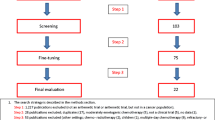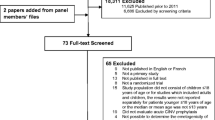Abstract
Background
We assessed adherence to the European Society of Medical Oncology (ESMO)/Multinational Association of Supportive Care in Cancer recommendations for prophylaxis of chemotherapy-induced nausea and vomiting (CINV) at our institution.
Patients and methods
The charts of 299 patients starting a new chemotherapy between November 2008 and April 2009 were reviewed. Baseline characteristics and prophylaxis of CINV during the first cycle were recorded, and adherence to ESMO recommendations was determined. Chi-square tests and logistic regression were used to test for predictors of adherence.
Results
Prophylaxis of acute CINV was not adherent in 39% of the patients: 39 of 54 patients with low emetogenic chemotherapy had a serotonin antagonist, and 24 of 100 with moderately emetogenic therapy had a neurokinin antagonist. Nevertheless, 71% of the patients treated with highly emetogenic therapy received the guideline-specified prescription. Prophylaxis of delayed CINV was not adherent in 89% of the patients: 101 of 125 patients with highly or moderately emetogenic single-day chemotherapy received a serotonin antagonist. Male gender (odds ratio (OR) 0.484, 95% confidence interval (CI) 0.291–0.806; P = 0.005) and hematologic neoplasia (OR 2.151, 95% CI 1.19–3.887; P = 0.011) were independent predictors of non-adherence. Age (OR 0.981, 95% CI 0.964–0.998; P = 0.029) and inpatient treatment (OR 0.457, 95% CI 0.25–0.836; P = 0.011) indicated a lower risk of non-adherence.
Conclusion
Contrary to older studies reporting frequent omissions of corticosteroids, the current study demonstrated significant overuse of serotonin antagonists for prophylaxis of delayed CINV.

Similar content being viewed by others
References
Ioannidis JP, Hesketh PJ, Lau J (2000) Contribution of dexamethasone to control of chemotherapy-induced nausea and vomiting: a meta-analysis of randomized evidence. J Clin Oncol 18:3409–3422
Navari RM, Kaplan HG, Gralla RJ et al (1994) Efficacy and safety of granisetron, a selective 5-hydroxytryptamine-3 receptor antagonist, in the prevention of nausea and vomiting induced by high-dose cisplatin. J Clin Oncol 12:2204–2210
Roila F, Tonato M, Cognetti F et al (1991) Prevention of cisplatin-induced emesis: a double-blind multicenter randomized crossover study comparing ondansetron and ondansetron plus dexamethasone. J Clin Oncol 9:675–678
Hesketh PJ, Grunberg SM, Gralla RJ (2003) The oral neurokinin-1 antagonist aprepitant for the prevention of chemotherapy-induced nausea and vomiting: a multinational, randomized, double-blind, placebo-controlled trial in patients receiving high-dose cisplatin—the aprepitant protocol 052 study group. J Clin Oncol 15:4112–4119
Gralla RJ, Itri LM, Pisko SE et al (1981) Antiemetic efficacy of high-dose metoclopramide: randomized trials with placebo and prochlorperazine in patients with chemotherapy-induced nausea and vomiting. N Engl J Med 305:905–909
The Antiemetic Subcommittee of the Multinational Association of Supportive Care in Cancer (MASCC) (2006) Prevention of chemotherapy- and radiotherapy-induced emesis: results of the 2004 Perugia International Antiemetic Consensus Conference. Ann Oncol 17:20–28
Gralla RJ, Roila F, Tonato M et al (2005) The 2004 Perugia Antiemetic Consensus Guideline process: methods, procedures, and participants. Support Care Cancer 13:77–79
American Society of Clinical Oncology (2008) Clinical practice guideline update: use of chemotherapy and radiation therapy protectants. J Clin Oncol 27(1):127–145
National Comprehensive Cancer Network (2006) Guidelines for supportive care, antiemesis. www.nccn.org
Herrstedt J, Roila F (2008) Chemotherapy-induced nausea and vomiting: ESMO clinical recommendations for prophylaxis. Ann Oncol 19:ii110–ii112
Herrstedt J, Roila F (2009) Chemotherapy-induced nausea and vomiting: ESMO clinical recommendations for prophylaxis. Ann Oncol 20:iv156–iv158
Roila F, Herrstedt J, Aapro M, ESMO/MASCC Guidelines Working Group et al (2010) Guideline update for MASCC and ESMO in the prevention of chemotherapy- and radiotherapy-induced nausea and vomiting: results of the Perugia consensus conference. Ann Oncol 21(Suppl 5):v232–v243
Nolte MJ et al (1998) Assuring the optimal use of serotonin antagonist antiemetics: the process for development and implementation of institutional antiemetic guidelines at Memorial Sloan-Kettering Cancer Center. J Clin Oncol 16(2):771–778
The Italian Group for Antiemetic Research (1998) Transferability to clinical practice of the results of controlled clinical trials: the case of antiemetic prophylactic treatment for cancer chemotherapy-induced nausea and vomiting. Ann Oncol 9:759–765
De Angelis V, Roila F, Patoia L et al (2000) Impact on antiemetic prescriptions of the Consensus Conference (CC) and of an expert’s visit to oncological centers. Proc Am Soc Clin Oncol 19:606a, abstr
Mertens WC, Higby DJ, Brown D, Parisi R, Fitzgerald J, Benjamin EM, Lindenauer PK (2003) Improving the care of patients with regard to chemotherapy-induced nausea and emesis: the effect of feedback to clinicians on adherence to antiemetic prescribing guidelines. J Clin Oncol 21(7):1373–1378
Kaiser R (2005) Antiemetic guidelines: are they being used? Lancet Oncol 6:622–625
Axelrod L (2001) Corticosteroid therapy. In: Becker LB (ed) Principles and practice of endocrinology and metabolism, 3rd edn. Lippincott Williams & Wilkins, Baltimore, pp 751–762
Rapoport B et al (2010) Aprepitant for the prevention of chemotherapy-induced nausea and vomiting associated with a broad range of moderately emetogenic chemotherapies and tumor types: a randomized, double-blind study. Support Care Cancer 18(4):423–431
Gralla RJ, Osoba D, Kris MG et al (1999) Recommendations for the use of antiemetics: evidence-based, clinical practice guidelines. American Society of Clinical Oncology. J Clin Oncol 17:2971–2994
Roila F, De Angelis V, Patoia L et al (2000) Antiemetic prescriptions in 77 Italian oncological centers after MASCC consensus conference. Support Care Cancer 8:241
O’Kane (2009) Evaluate the effects of implementing the Multinational Association of Supportive Care in Cancer (MASCC) antiemetic guideline on the incidence of chemotherapy-induced nausea and vomiting (CINV) following platinum chemotherapy. Support Care Cancer 17:875
Teich JM, Merchia PR, Schmiz JL, Kuperman GJ (2000) Effects of computerized physician order entry on prescribing practices. Arch Intern Med 160:2741–2747
Cherny N et al (2010) European Society for Medical Oncology (ESMO) program for the integration of oncology and palliative care: a 5-year review of the designated centers’ incentive program. Ann Oncol 21(2):362–369
Acknowledgments
The authors would like to thank Daniel Ratschiller for database management. An acknowledgment should also go to Jürg Bernhard for his comments.
Potential conflicts of interest
The authors declare no conflicts of interest.
Author information
Authors and Affiliations
Corresponding author
Appendix
Appendix
Rights and permissions
About this article
Cite this article
Burmeister, H., Aebi, S., Studer, C. et al. Adherence to ESMO clinical recommendations for prophylaxis of chemotherapy-induced nausea and vomiting. Support Care Cancer 20, 141–147 (2012). https://doi.org/10.1007/s00520-010-1079-3
Received:
Accepted:
Published:
Issue Date:
DOI: https://doi.org/10.1007/s00520-010-1079-3




